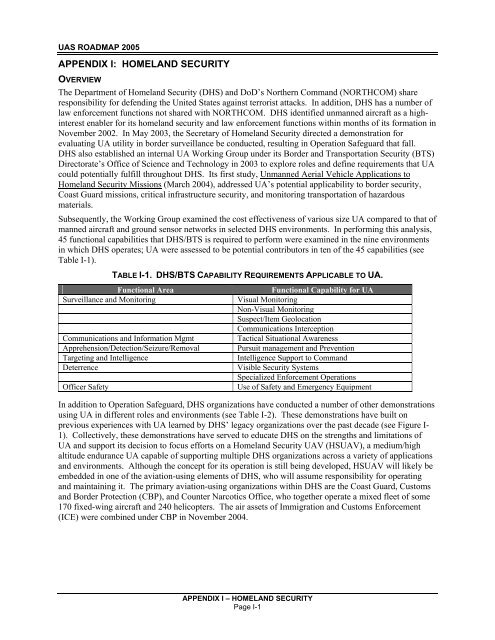Unmanned Aircraft Systems Roadmap 2005-2030 - Federation of ...
Unmanned Aircraft Systems Roadmap 2005-2030 - Federation of ...
Unmanned Aircraft Systems Roadmap 2005-2030 - Federation of ...
Create successful ePaper yourself
Turn your PDF publications into a flip-book with our unique Google optimized e-Paper software.
UAS ROADMAP <strong>2005</strong><br />
APPENDIX I: HOMELAND SECURITY<br />
OVERVIEW<br />
The Department <strong>of</strong> Homeland Security (DHS) and DoD’s Northern Command (NORTHCOM) share<br />
responsibility for defending the United States against terrorist attacks. In addition, DHS has a number <strong>of</strong><br />
law enforcement functions not shared with NORTHCOM. DHS identified unmanned aircraft as a highinterest<br />
enabler for its homeland security and law enforcement functions within months <strong>of</strong> its formation in<br />
November 2002. In May 2003, the Secretary <strong>of</strong> Homeland Security directed a demonstration for<br />
evaluating UA utility in border surveillance be conducted, resulting in Operation Safeguard that fall.<br />
DHS also established an internal UA Working Group under its Border and Transportation Security (BTS)<br />
Directorate’s Office <strong>of</strong> Science and Technology in 2003 to explore roles and define requirements that UA<br />
could potentially fulfill throughout DHS. Its first study, <strong>Unmanned</strong> Aerial Vehicle Applications to<br />
Homeland Security Missions (March 2004), addressed UA’s potential applicability to border security,<br />
Coast Guard missions, critical infrastructure security, and monitoring transportation <strong>of</strong> hazardous<br />
materials.<br />
Subsequently, the Working Group examined the cost effectiveness <strong>of</strong> various size UA compared to that <strong>of</strong><br />
manned aircraft and ground sensor networks in selected DHS environments. In performing this analysis,<br />
45 functional capabilities that DHS/BTS is required to perform were examined in the nine environments<br />
in which DHS operates; UA were assessed to be potential contributors in ten <strong>of</strong> the 45 capabilities (see<br />
Table I-1).<br />
TABLE I-1. DHS/BTS CAPABILITY REQUIREMENTS APPLICABLE TO UA.<br />
Functional Area Functional Capability for UA<br />
Surveillance and Monitoring Visual Monitoring<br />
Non-Visual Monitoring<br />
Suspect/Item Geolocation<br />
Communications Interception<br />
Communications and Information Mgmt Tactical Situational Awareness<br />
Apprehension/Detection/Seizure/Removal Pursuit management and Prevention<br />
Targeting and Intelligence Intelligence Support to Command<br />
Deterrence Visible Security <strong>Systems</strong><br />
Specialized Enforcement Operations<br />
Officer Safety Use <strong>of</strong> Safety and Emergency Equipment<br />
In addition to Operation Safeguard, DHS organizations have conducted a number <strong>of</strong> other demonstrations<br />
using UA in different roles and environments (see Table I-2). These demonstrations have built on<br />
previous experiences with UA learned by DHS’ legacy organizations over the past decade (see Figure I-<br />
1). Collectively, these demonstrations have served to educate DHS on the strengths and limitations <strong>of</strong><br />
UA and support its decision to focus efforts on a Homeland Security UAV (HSUAV), a medium/high<br />
altitude endurance UA capable <strong>of</strong> supporting multiple DHS organizations across a variety <strong>of</strong> applications<br />
and environments. Although the concept for its operation is still being developed, HSUAV will likely be<br />
embedded in one <strong>of</strong> the aviation-using elements <strong>of</strong> DHS, who will assume responsibility for operating<br />
and maintaining it. The primary aviation-using organizations within DHS are the Coast Guard, Customs<br />
and Border Protection (CBP), and Counter Narcotics Office, who together operate a mixed fleet <strong>of</strong> some<br />
170 fixed-wing aircraft and 240 helicopters. The air assets <strong>of</strong> Immigration and Customs Enforcement<br />
(ICE) were combined under CBP in November 2004.<br />
APPENDIX I – HOMELAND SECURITY<br />
Page I-1
















